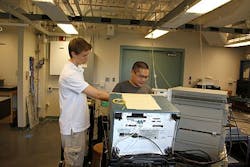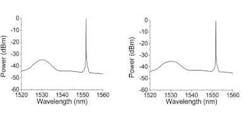Over the summer of 2013, I interned with MIRTHE—the National Science Foundation (NSF)-sponsored Engineering Research Center for Mid Infra-Red Technologies for Health and the Environment—in professor Paul Prucnal’s lab at Princeton University (Princeton, NJ). During the summer program, I worked directly with graduate student Ben Wu (see Fig. 1). Wu’s doctoral research is focused on optical steganography and during the time we worked together, we concentrated on secure data transmission over the optical network through the use of phase-mask encryption.
The research that we completed over the summer was presented at the 2013 MIRTHE Summer Workshop. During this one-week conference, interns and graduate students from all of the participating MIRTHE universities gathered at Princeton to present their work and to attend seminars on related topics. The conference allowed me to publicly share my work, learn more about the research that was happening in the other labs, and build a network of like-minded people that shared similar interests with me.
Cyber security
Security over the cyber network is of importance as the world progresses to a more technological state. As the world becomes more reliant on advances in technology for day-to-day transactions and communication, it is of paramount significance to protect confidential information from eavesdroppers with ill intent. The Lightwave Communication Lab in Princeton University’s Electrical Engineering Department is one of the leading research groups in this field.
Optical steganography aims to transmit stealth signals in public fiber-optic communication systems without being detected.1 Amplified spontaneous emission (ASE) noise is generated in the transmission lines from erbium-doped fiber amplifiers (EDFAs). Transmitting information using the ASE noise has previously been demonstrated.2, 3
Parties on both the transmitting and receiving end of a signal predetermine a delay key. Although the delay would normally work as a viable key, the time delay is changed mechanically and can only be altered on the order of several seconds. Because of this relatively long time window, the eavesdropper can use fast-scanning techniques to discover the delay length before it is changed, which raises a need for a much faster, dynamic method to encrypt the stealth signal.
Under Wu’s guidance, our work at Princeton concerned phase-mask encryption (see Fig. 2). The phase mask encrypts the stealth channel with the addition of a random code to the signal and the mask can be changed at a much faster rate than a delay line. The encrypted signal has both its amplitude reduced to the noise level and is phase randomized.
Overall, the information is protected on two levels. To camouflage the signal in the spectral domain, the stealth signal matches the ASE noise that exists in the fiber-optic communication network. In addition, to conceal the signal in the time domain, the delay line and fast-changing phase mask code allows only the receiver with information for delay length and phase-mask code to receive the stealth data. In summary, optical steganography with phase-mask encryption has great potential for creating fast, secure data transmission over the existing public optical channel.
The internship was remarkable in many ways. Not only was I exposed to, and a part of, cutting-edge research that could ultimately impact national security, but I also was given opportunities not available to most high school students. In addition to working with world-class researchers, I was introduced to many of the tools and software that engineers use daily, learning new software such as VPI and MATLAB to assist in running simulations and becoming familiar with lab tools such as oscilloscopes, pattern generators, photodiodes, intensity modulators, and distributed-feedback lasers. This program exposes youth to the research environment and encourages photonics STEM study and careers; I was honored to be a part of MIRTHE’s research and formed many new relationships that will last a lifetime.
This material is based upon work supported by the National Science Foundation under Grant No. EEC-0540832.
REFERENCES
1. B. Wu and E. E. Nariminov, Opt. Exp., 14, 3738–3751 (2006).
2. B. Wu et al., Opt. Exp., 21, 2065–2071 (2013).
3. B. Wu et al., Proc. IEEE Photon. Conf., paper MG3.3, Bellevue, WA (2013).
—Nicholas Frost; [email protected]

